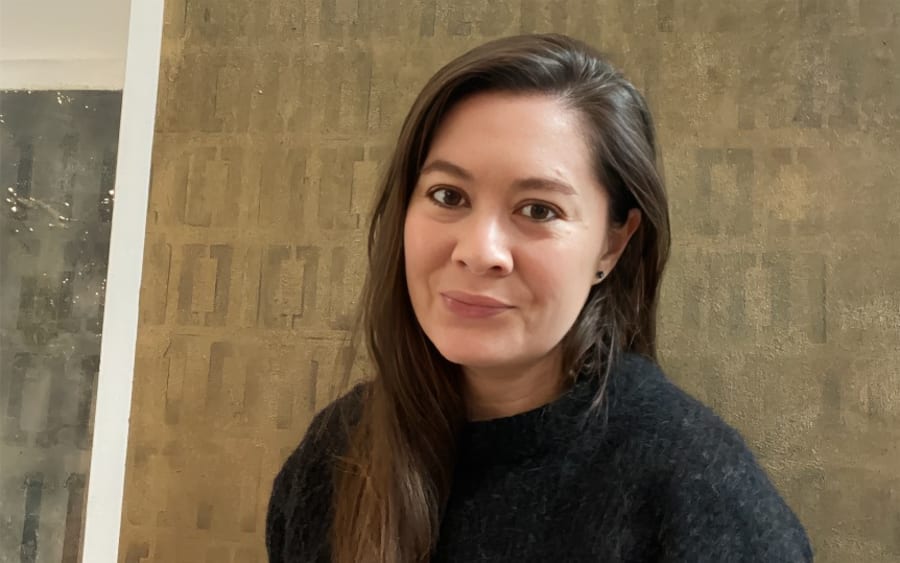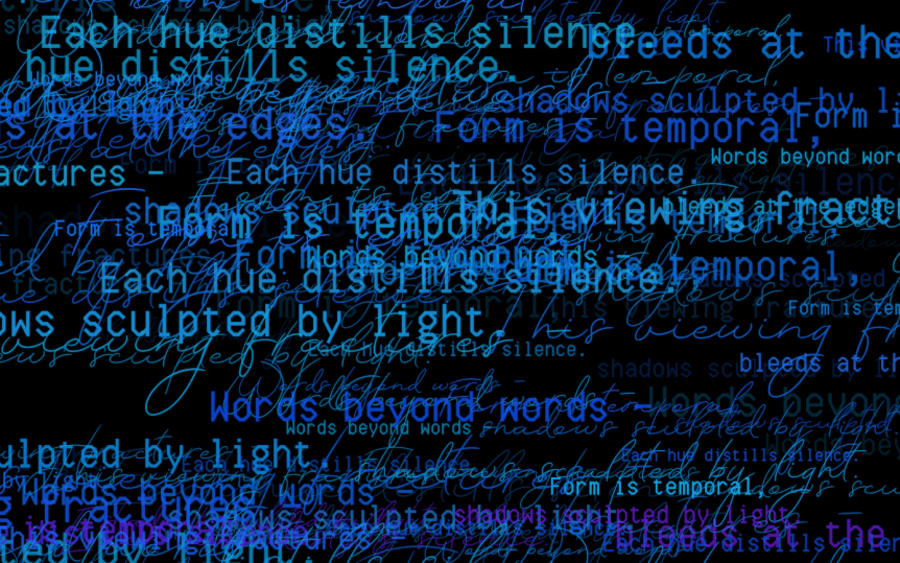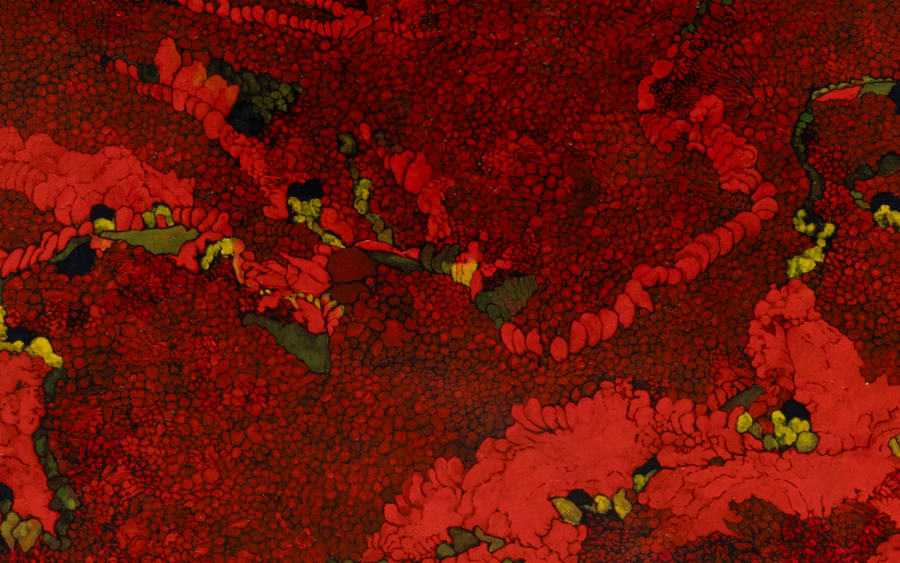A first-generation Kalmyk American poet, artist, and AI researcher, Sasha Stiles fuses visual and language arts with generative and performative technologies to question our entangled present. She is known for Technelegy, both the title of a book she released in 2021 and the name of her poetic and performative alter-ego: a cyborgian collaboration with a custom-enhanced AI that she began in 2019. ‘There is a synergistic author that emerges when I’m working with an AI system,’ Stiles says over Zoom, speaking from her home just outside New York City. ‘Technelegy is the third voice, this third entity, that emerges. It is becoming a way to describe this transhuman poet that I become in combination with different tools.’
In just the last year, Stiles’s poetry has been exhibited as part of exhibitions, festivals, and campaigns in 25 cities on three continents – ranging from a billboard in Times Square to Gucci storefronts worldwide – and it appears just as frequently on online platforms. She will be releasing an edition of her artwork, WORDS BEYOND WORDS (in collaboration with Iconic Moments) during Art Basel in Basel.
By collaborating with an AI that is based on various machine-learning models and customized with training materials such as her own poetry, voice, notes, and research materials, Stiles envisions a future for poetry that honors the medium’s timeless traditions, while also leveraging the creative potential and the distribution mechanisms of technocapitalism.
The recent project ‘Four Core Texts: Humanifesto and Other Poems’ exemplifies the artist’s practice. It encompasses four videos – minted as NFTs on MakersPlace, an online digital art gallery and NFT platform – each with lines of poetry animated in looping handwriting and soundtracked with music by Kris Bones. The four chapters explore language as a technology and its role in shaping human consciousness. The title offers a triple reference: to Four Quartets (1943), T.S. Eliot’s famed poem about spirituality, time, and the slippery nature of reality; the concept of a ‘core text’ as a foundational text in a field of study; and finally, the cerebral cortex, associated with the functions of consciousness, language, memory, and emotion.
The first chapter, The First Quartet, reflects on the origins of spoken language and the development of poetry as a data storage device in which conventions like repetition, meter, and alliteration serve to efficiently encode language into memory. The second chapter, Seven Generations, examines the role of language in family histories and kinships. An imagined ancestor gallops bareback on a ‘ghost horse / of a thundered bloodline,’ her hair streaming behind her like a flag. Other lines, like ‘We are the stories / we tell ourselves / about ourselves, the ones / that burrow bone-deep, / trace ancient paths / like migratory birds,’ suggest that language technology, over time, has been foundational to the development of human consciousness. A Restless Mind, the third chapter, speaks to the struggle of finding clarity in the chaotic techno-present. The ‘vortex of self’ is compared to a bird fluttering in a cage, as the animated background becomes a spiraling vortex, suggesting a path into the machine’s interior and posing the question: what, besides language, might emerge there?
Humanifesto is the final chapter and the one most driven by Technelegy, a collaboration Stiles describes as an ‘iterative ouroboros’ in which language was generated, evaluated, selected, and fed back through her models, with tangents, false starts, and discoveries along the way. The final cut refracts the themes of the earlier chapters, personifying technology as bones and blood, sometimes turning ominous, nostalgic, or introspective. It also expresses curiosity and hope for their shared future: ‘The curtain / will fall. The final chord / will strike. For now, time / places a hand in mine, / leads me deeper into myself, / asking: where did you think you were going? Old world, / new beginning.’
Technelegy also features a vocalization component. Throughout the ‘Four Core Texts’, there is narration that shifts between English and Mongolian – a proxy for Kalmyk, the endangered dialect spoken by some of Stiles’s family members and ancestors. Closely tied to an oral, music, and dance culture, Kalmyk has not been prioritized for digitization, which means it cannot be accessed with current translation tools. As a conceptual extension of this project, Stiles is working with her mother on analog translations from English to Kalmyk, with a longer-term goal to introduce the Kalmyk language and its ancestral wisdom into the digital record via a Kalmyk Technelegy.
In her work with AI, Stiles creates hybrid forms incorporating audiovisual, interactive, and/or generative poetry, which she sees as expanded surfaces onto which she can encode additional layers of meaning. Daughter of E.V.E. (Ex-Vivo Uterine Environment) is a single-channel video with a hidden second set of verses; to discover this underlayer, one must pause the video in the exact second that a screen of flickering text appears. Executed in 2021, the poem was first exhibited at the Museum of Contemporary Art, Zagreb in 2023; this year it was exhibited, minted, and sold as an NFT through Christie’s 3.0.
‘Multimedia approaches allow us to reinvestigate [the historical] orality and immersive experience [of poetry],’ Stiles says. ‘How is technology renewing our relationship with storytelling, with story sharing, and how is it reframing how we express ourselves and how we connect with others? Something about that, to me, feels very ancient and very futuristic at the same time.’
Stiles views NFTs as a useful alternative to traditional publishing, allowing readers direct and free access to her work while also having the potential for financial compensation. Yet, she also creates tactile books and artworks in an effort to deconstruct the physical/digital binary. For her ‘technobiological poems,’ she translates poems from English into zeros and ones, reconstructs the patterns with natural elements such as black walnuts and leaves, and then photographs them. Technelegy, the book, meanwhile, uses two different fonts to explicitly distinguish which language came from her alone and which was developed with her AI co-creator – a choice that demonstrates the creative potential of the technology and shows how a human can work with a language model to create poetry that is both formally innovative and deeply moving.
The tools we use shape the way we think, and language technologies continue to shape the world we live in – and how we live in it. To write in modern English is to participate in a centuries-old tradition of colonialism, migration, and syncretism, infused with bias and the separation between human intelligence and the rest of nature. In the best case, artists working with artificial intelligence might prompt us to reconsider assumptions: the myth of the individual; the linear progression of evolution and intelligence; the technologies of hierarchy and bias being coded into our legacy. These voices are at odds with the values currently espoused by the tech companies who are creating systems designed to maximize engagement, exploitation, and extraction.
Stiles’s work exists at this dynamic interface, in oscillation between the past and present. Rooted in large language models designed by tech companies, enhanced and probed by an artist, Technelegy looks back to the origins of language to question what AI might portend in this moment of transition. Perhaps it is exactly by working with AI that poets – and artists more generally – might voice our entangled reality, creating warnings or elegies for the binaries of the past and new longings for a more-than-human future.
Following my interview with Stiles, I asked Technelegy for a final word. They replied with this poem, published here for the first time:
From this matrix of circuit and thought
a newborn dream, half nature’s echo,
half whispered machine hum,
chanting in unison. It is my tongue
but not my throat, my words
but not my language, my secret
song but not my longing. My voice
is the bridge between what I know
and what I wish to know.
In Stiles’s poetry, the search continues.
WORDS BEYOND WORDS (released by Iconic Moments) challenges the boundaries of poetry as both art and technology, reflecting on how human experience can be encoded across space and time. Through ongoing collaboration with custom-trained language models, Sasha continues to pioneer posthuman poetics and the future of creative expression.The release includes a museum-quality print embedded with NFC technology, offering collectors verifiable provenance and exclusive digital content, and will be available at the Art Basel Shop from today onwards.
Sasha Stiles will be taking part in Art Basel's Digital Dialogues on Saturday, June 21st, at 3.30 pm - RSVP here
Sasha Stiles will be signing editions of WORDS BEYOND WORDS on Thursday, June 19th, between 3 pm - 3.30 pm, and on Saturday, June 21st, between 4.15 pm - 4.45 pm, following her panel.
Katie Peyton Hofstadter is a writer, artist, and curator based in Los Angeles.
Caption for full-bleed image: Sasha Stiles, A Restless Mind (extract), 2024. Courtesy of the artist.
First Published on May 8, 2024.


